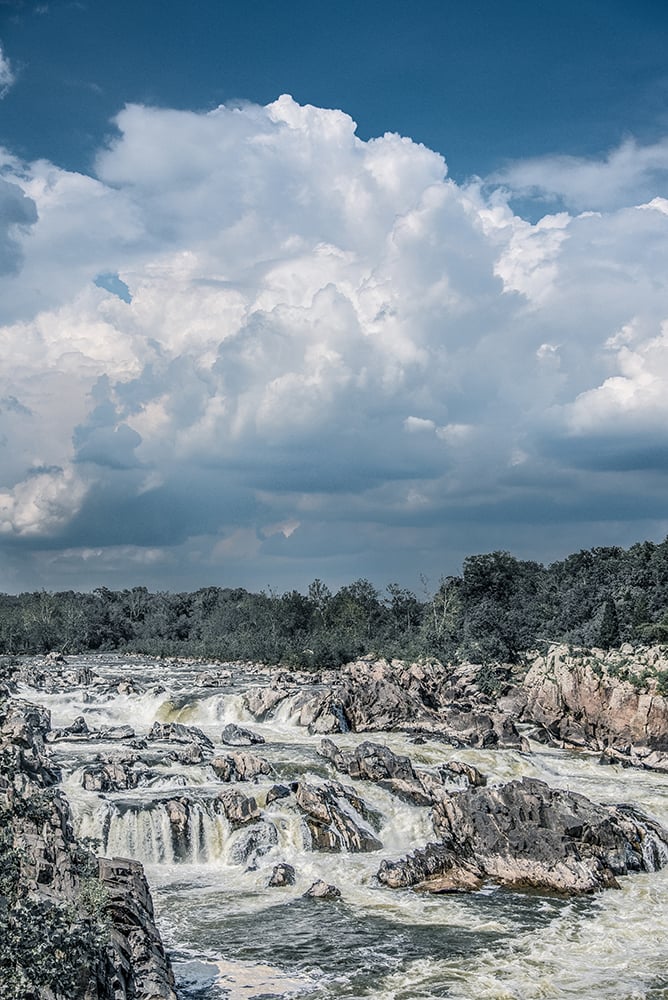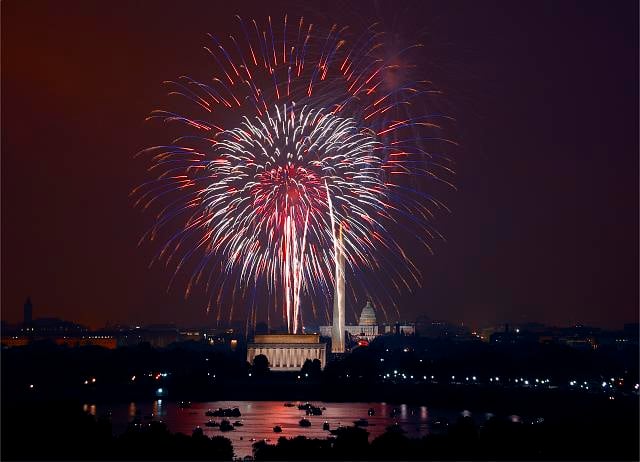Contents
- No Longer A “Disgrace”: The Potomac Is Cleaner Than It’s Been in Years
- Life on the River: The Dolphin Expert
- Life on the River: The Potomac’s Watchdog
- Life on the River: The “SUP Garbage Man”
- Life on the River: The Culture Keeper
- Life on the River: The Anacostia’s Hero
- 22 Great Walks Along the Water
- 20 Ways to Get Out on the Water
- The Anacostia River: Forgotten No More?
- Why Is There So Little Development Along the Potomac?
- Three Fascinating Plants to Look for in the Potomac Watershed
- Presidents and the Potomac
- Three Animals You May Be Surprised to See in the Potomac
“I go to nature to be soothed and healed, and to have my senses put in order.”
—Naturalist John Burroughs
It’s a mighty 383 miles long, it slices through the heart of our region, and it supplies most of our drinking water. Yet ask residents what they most love about Washington, and the Potomac River probably doesn’t pop to mind first.
“I think a lot of people overlook the river,” says Garrett Peck, author of The Potomac River: A History & Guide. Or they don’t have an entirely positive view of it, if they’re commuters who’ve been snarled in bottlenecks on a bridge. “The river is an obstacle to getting to and from work.”
Or was, until the coronavirus. Now, when so many of us want to be outside, the Potomac is there, offering solace and sport. This section of the magazine is to help you enjoy and appreciate the river—to learn a bit of its history and geology, to meet some people who spend time on it, to discover ways to get onto the water.
Because what you may not know is that the Potomac is unlike most other rivers.
“The Potomac is a natural river to this day, which is unusual,” Peck says. “You look at other cities, and their rivers are full of dams and levees. But you look at the Potomac, and it has just two major dams, way up in the West Virginia highlands, and one levee, at Georgetown Harbour. This is a wild river right at our doorstep, which is incredible.”
The Potomac starts as a trickle in West Virginia’s Fairfax Stone Historical Monument State Park, more than 3,000 feet above sea level. It winds through the Allegheny and Blue Ridge mountains in serpentine curves, widening at Harpers Ferry, where it’s met first by the Shenandoah River and then the Monocacy. After running past Maryland farmland, it tumbles over the boulders at Great Falls, dropping 77 feet in a mile, a fall line that continues through Georgetown. As another tributary, the Anacostia, joins it, the river opens up more, journeying an additional 100 miles or so—past Mount Vernon and Fort Washington, into the lusher Northern Neck, and finally flowing into the Chesapeake Bay at Point Lookout, Maryland.
“One thing that is really neat,” says Dean Naujoks, the Potomac riverkeeper, “is if you go 60 miles down river, it’s five miles wide, flat, and coastal, but if you go 60 miles upriver, it’s mountains. This river, 60 miles either way, is pretty amazing.”
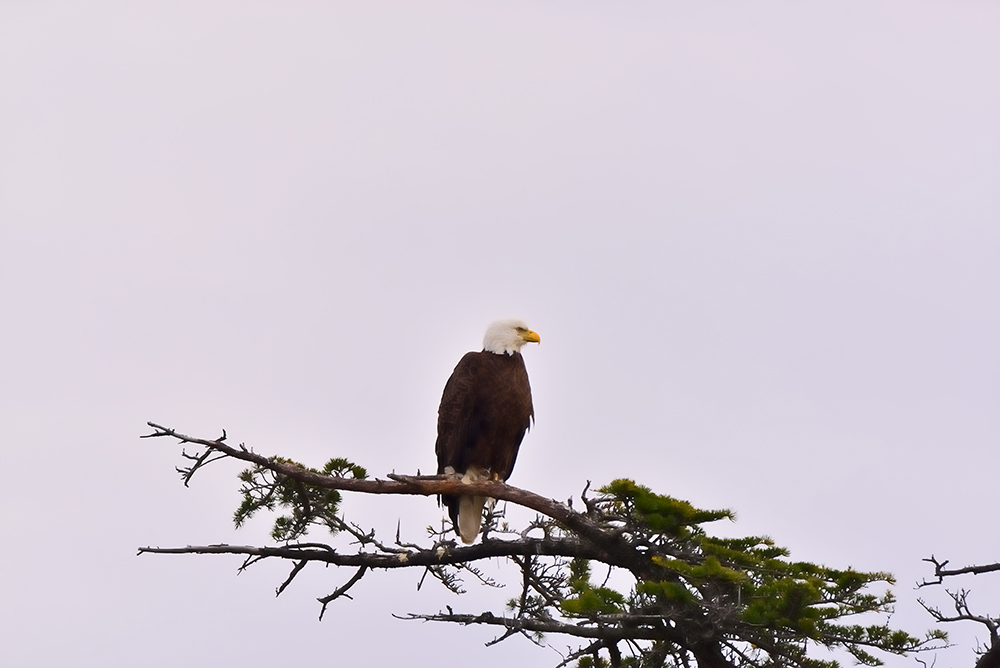
Our wild waterway is home to lots of wildlife—including dolphins, striped bass, and bald eagles—as well as wild vegetation. Mather Gorge, the area around Great Falls, is its own unique ecosystem. “There are plants there—you have to go 1,000 miles away to see them anywhere else,” says Mike Nardolilli, executive director of the Interstate Commission on the Potomac River Basin. “It’s a very valuable ecological resource.”
We haven’t always taken care of this resource. Centuries of farming, industry, and development trashed the river, literally, though its health has rebounded in recent decades. (See page 37.)
Despite what some history books might suggest, Captain John Smith did not discover the Potomac.
“If you look at the John Smith map of 1608, you see the extent of how many native people, all these towns and villages on every tributary—they’re all there,” says Gabrielle Tayac, a member of the Piscataway Indian Nation who worked at the National Museum of the American Indian for 18 years. “I think it’s important to understand that people were there for 10,000 years. Every time you say ‘Potomac’ or ‘Occoquan’ or ‘Anacostia,’ you are speaking Algonquian. Most of the places are named for the people who were there.”
Later came another key moment in the river’s timeline, when Congress gave George Washington a choice of five spots along the Potomac for the new nation’s capital. With more than a little self-interest, he selected the site closest to his Mount Vernon home.
The river in DC was wider in Colonial days. Starting in the late 1800s, mud flats south and west of the Washington Monument were filled in, creating East and West Potomac parks—land on which the Jefferson and Lincoln memorials sit. Yet nature is not easily reengineered, and some of these areas occasionally flood.
George Washington had originally proposed using the river, along with canals, to transport goods and people between Georgetown and Pittsburgh, a plan that never fully came to pass. But the half-finished canal—it stopped in Cumberland, Maryland—would have a more lasting impact. As C&O Canal National Historical Park, the land has served as a 184-mile-long buffer, protecting access to and green space along the Maryland side of almost half the river.
In some ways, Maryland has been a better steward of the Potomac—you see more development on the Virginia banks. That may be because the Free State owns the river.
While there’s more these days in connecting to nature, there are those who all along have respected and used our local waterways—Olympic kayakers who train at Great Falls, rowing teams that ply the river around Georgetown and Bladensburg, boaters who dock in Alexandria.
Gabrielle Tayac even named her daughter after the Potomac. “Her name is Jansikwe, which means ‘beautiful river woman,’ ” she says. The Piscataway “look at it as a vein of Mother Earth, a beautiful life source. I would encourage people, when they go to the river, to not think of it just in terms of recreation, of what we extract from it. But that it goes both ways.”

No Longer A “Disgrace”: The Potomac Is Cleaner Than It’s Been in Years
But you still shouldn’t swim in it.
When Mike Nardolilli was ten, his grandparents brought him to Washington for the first time.
“It was 1966, and I remember visiting Mount Vernon and going down to the dock,” recalls Nardolilli, now executive director of the Interstate Commission on the Potomac River Basin. “I was astounded to see how poor the river was. It smelled, it had dead fish in it, it had blue-green algae on it.”
He wasn’t alone in his disgust. The year before, then-President Lyndon Johnson had called the river “disgraceful.”
More than 40 years later, the river still has issues, but it’s much cleaner—earning a B in the Potomac Conservancy’s most recent report card, issued in 2018. Just ten years earlier, it got a D.
About three-quarters of this area’s drinking water is pulled from the Potomac, treated, and piped through our taps. Starting with less-contaminated water can’t hurt. Cleaner water doesn’t just help human health: It means more fish, which means more bald eagles and other birds that feast on the fish.
A number of factors contributed to the river’s turnaround. The Clean Water Act of 1972 reduced pollutants from sources such as sewage-treatment plants. Other federal, state, and nonprofit efforts decreased chemical and sediment runoff from farms, lawns, streets, and other harder-to-pinpoint sources.
“We’ve seen tremendous pollution reductions in the last four or five decades,” says Hedrick Belin, president of the Potomac Conservancy. “It’s a great success story.”
Yet despite the progress, Belin cautions, “there’s still work to be done.”
Storm runoff remains a problem—it washes trash, road salt, and other pollutants off streets and sidewalks into waterways. Urban and suburban run-off is increasing, he says, because of development—forests and other porous buffer zones that absorb and filter rainwater are being replaced with impervious surfaces, such as roofs and parking lots, which don’t.
Stormwater overwhelms DC’s sewer systems, causing raw sewage to overflow into the river—one reason why swimming in the river is illegal in and around the District. DC Water’s Clean Rivers Project is working to address this issue.
“The river defines a lot of DC,” Belin says. “I think it’s great that instead of turning our backs on the river in the last few decades, we have embraced and supported it.”

Life on the River: The Dolphin Expert
When Janet Mann was 14, she saw anthropologist Jane Goodall on TV talking about chimpanzees. The next day, she took out every book on primates from her library in Roslyn, New York.
“From an early age, I was interested in animals and biology,” says Mann, 60. “Everybody thought that you couldn’t make a career out of this. But I did.”
After studying baboons in Africa as an undergraduate, Mann ended up in Australia researching dolphins. That was some 30 years ago. To-day, the Georgetown University professor is director of the Potomac-Chesapeake Dolphin Project.
In 2012, she bought a cottage in the Northern Neck. “At the marina, I said to someone, ‘We’re starting this dolphin project,’ and he said, ‘There are no dolphins here.’ ”
But there were—at last count, Mann and her team have identified more than 1,200, thanks to distinctive dorsal fins. Mann’s crew names each after a famous Washingtonian, meaning there’s both a Donald Trump and a Nancy Pelosi swimming about.
“People think you have to travel so far to see these big, exciting animals,” Mann says. “The hypothesis, which we don’t know if we can answer, is this is because the Potomac is getting cleaner.”
Dolphins prefer brackish water; the river in and near DC is, sadly, freshwater. But dolphins abound in the Northern Neck.
“The lower Potomac doesn’t look anything like it does in DC. It’s wilder. We’ve even seen giant green turtles,” she says. “The last time I was on the water, I saw over 150 dolphins in eight to ten hours. What I would recommend is to get an Airbnb—most come with kayaks. Or do a fishing tour. Dolphins like to go where the fish are, so if you go out fishing, you have a decent chance.”
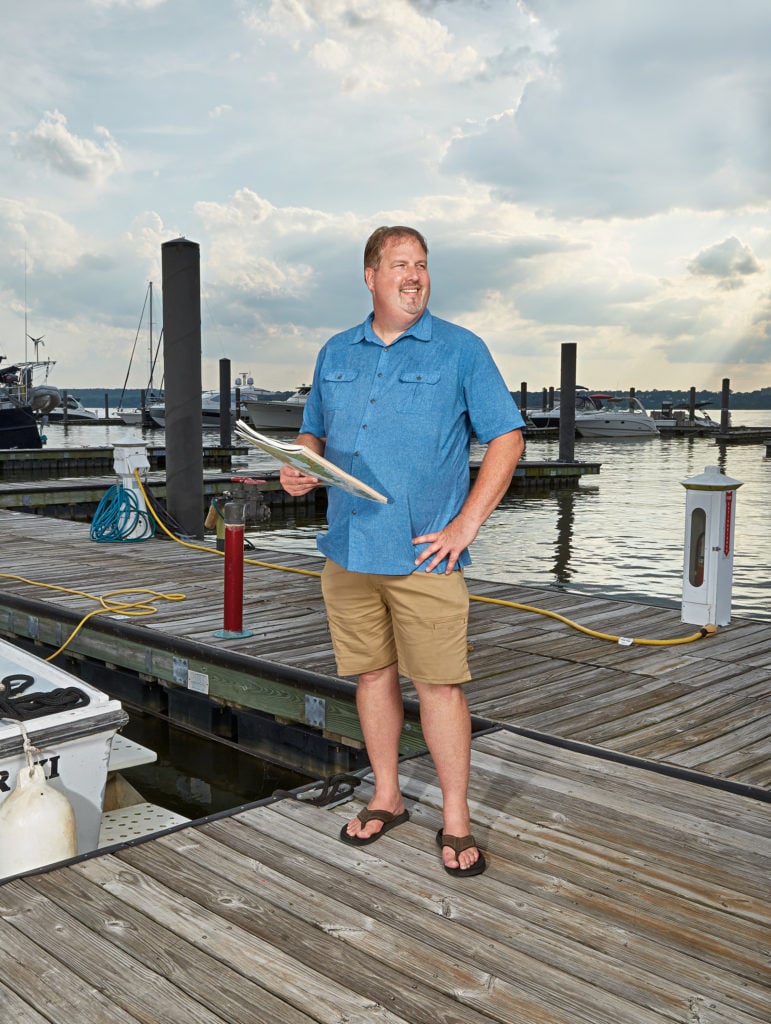
Life on the River: The Potomac’s Watchdog
Shortly after Dean Naujoks became the Potomac riverkeeper in 2015, he set out to kayak almost the entire 383-mile stretch. Two weeks into what would be a three-week paddle, the effects of Hurricane Joaquin blew him temporarily out of the water.
“The river was six feet above normal, and it seemed like I was doing 30 miles an hour on Class V rapids,” Naujoks recalls. “I got stranded on Hains Point and had to take my kayak and strap it to a fence and walk up the point in waist-deep water.”
Naujoks, 51, is used to challenge. It’s part of the job as a riverkeeper.
“What we do is we work to enforce clean-water laws,” says Naujoks. “We find the biggest polluters and work to get them into compliance.”
One example: Alexandria’s combined sewer system. “They were going to fix three discharge points for combined sewage and stormwater, but a fourth one dumping 70 million gallons of sewage a year upstream from Old Town, they weren’t going to fix that one until at least 2040. We worked with lawmakers on a bill that forced them to do it by 2025.”
Before becoming the Potomac’s watchdog, the Pennsylvania native was a riverkeeper in North Carolina.
“A lot of people think there’s someone in a state capacity making sure these guys aren’t breaking the laws,” he says. “But they don’t have enough staff. And there’s a lot of political pressure. So it’s not surprising to us that we are constantly finding problems.
“This day and age, when we have an EPA that is not doing any enforcement work and state agencies are reluctant to drop the hammer, we are the last line of defense. I’ve been doing this for 19 years, and I feel our work has never been more important.”
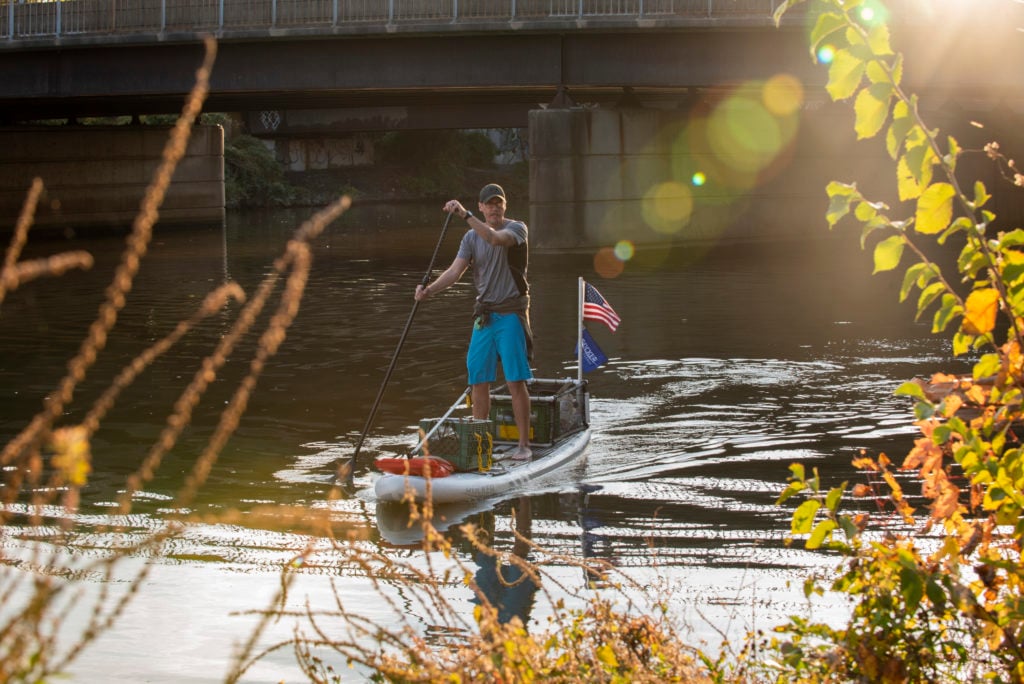
Life on the River: The “SUP Garbage Man”
He’s come across orange construction cones, child car seats, Nerf darts, syringes.
“It’s shocking the amount of trash out there,” says Joe Wright about the Potomac. He should know: Four or five days a week, he slides his standup paddleboard, or SUP, onto the river and goes to pick up garbage.
Wright, who lives in Alexandria near Fort Hunt, start-ed scooping trash from the river in May 2019. “One day, I was paddling and saw something white floating in the middle of the river. It was a couple of Styrofoam containers tied in a plastic bag. I grabbed it. Then I came across a spot where the current had brought in a lot of trash. So I thought, Tomorrow, I’ll come with a milk crate and pick this stuff up.By the third day, I thought, I need to show people what’s out there. So I started an Instagram account.”
As of late July, Wright estimates he has collected more than 1,600 cubic feet of trash off the Potomac, but he has plucked more than that in his life. When he was a child, his mother made it a game for him and his sister to pick up trash on walks.
Despite the debris, Wright, who is in his late thirties, loves the river.
“I find a certain freedom in the middle of water,” he says. “The road noise drowns away, you can hear birds. I’m out there away from everything.”

Life on the River: The Culture Keeper
A few years back, Julie Tayac Yates was fishing in Virginia’s Leesylvania State Park when a game warden asked to see her fishing license. Although she has one, she says, “I told him I did not need a fishing license because I am Native American. When the Europeans came over in the 1600s and decided to take our land, there was a treaty which gave us fishing and hunting rights.”
Yates, a member of the Piscataway Indian Nation, was born in 1951 in St. Mary’s County, Maryland, where the Potomac joins the Chesapeake Bay. There, she fished and crabbed with her family, as her ancestors had done for centuries, and learned how to make fishing hooks out of catfish bone. Mostly, she learned to love the river, to read and listen to it. She still crabs, and she fishes the Potomac—usually at Quantico Marine base. She’ll bring home her catch—rockfish, bluegill, perch (though not catfish, due to its mercury content)—and often fry it up in her father’s 100-year-old cast-iron skillet.
While Yates doesn’t eat fish caught in the more polluted waters of the District, she and others recently got the DC Council to consider a bill that would honor the 1666 treaty and make fishing licenses free for the Piscataway people.
“I have four grandchildren,” Yates says. “They all fish. It’s important to me that they continue the legacy.”
Part of her family’s legacy is told at Piscataway Park in Fort Washington, where her father, Chief Turkey Tayac, is buried. “You can pick up pamphlets about the history of the Piscataway people,” she says. “There are over 500 Native Americans buried in that area. The history is there. Every time I go, I feel it. I can see my dad chewing tobacco and hear him telling stories.”
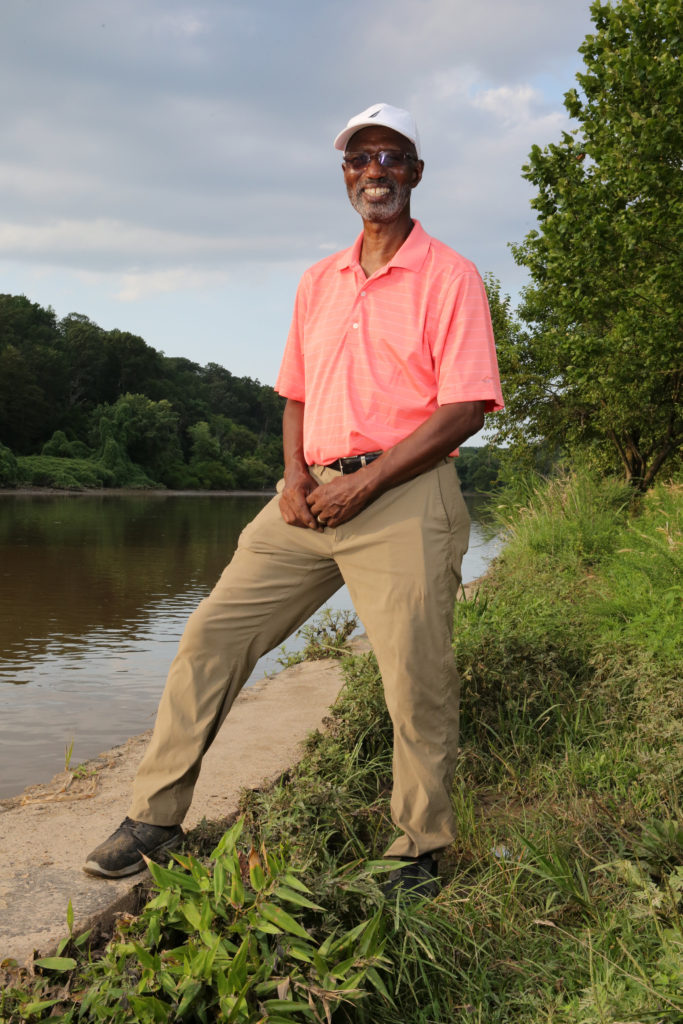
Life on the River: The Anacostia’s Hero
When Dennis Chestnut was growing up in Northeast DC’s Hillbrook in the 1950s and ’60s, reaching the closest swimming pool, in Anacostia Park, meant traveling through white neighborhoods where he and his friends didn’t always feel welcome. So on hot summer days, they jumped into Watts Branch stream where it meets the Anacostia River.
“I learned how to swim there. We treated it like our beach,” says Chestnut, 71. “The Anacostia has been near and dear to me ever since.”
It was legal to swim then in DC waterways—it’s not now. “We didn’t notice any trash,” he says. “It was pretty clean.”
After college, Chestnut came home to start a family and a career as a master carpenter. “When my children began to get old enough, they wanted to go to the same stream where I used to play,” he recalls. “I went with them, and I noticed that it was not in the same condition. It was trashed. My children were ready to play in it, and I couldn’t let them. That was in the mid-to-late ’70s. That’s when my stewardship light bulb went off.”
Chestnut volunteered for river cleanups, tree plantings, and other activities to better the watershed. Eventually, he helped found and then led Groundwork Anacostia River DC, part of a national non-profit focusing on environmental restoration and community development. In 2019, he was named a National River Hero by the River Network.
He now lives in the house where he grew up and occasionally walks to his old swimming hole, picking up any trash.
“The river is looking a lot better,” Chestnut says. “We are close to being able to swim in it on a regular basis—I would say within the next five to six years. They were originally talking about 2032, and I said, ‘At that rate, I won’t get a chance to go in.’ But five to six years isn’t far off.”
Back to Top22 Great Walks Along the Water
Trails and parks along the Potomac and its tributaries that offer waterside strolls—some with sweeping views.
Click here to view our guide to ‘Finding Your Walk.’
Back to Top20 Ways to Get Out on the Water
The Potomac and its tributaries offer boatloads of places to rent a kayak or standup paddleboard, set off on a guided boat ride, or cool off on the water. Here are some favorite local outings and day trips.
Click here to view our guide to ‘Getting Out on the Water.’

The Anacostia River: Forgotten No More?
The waterway is cleaner and more accessible than it’s been in years, but many Washingtonians still haven’t visited.
Over the years, the Anacostia has been called the “forgotten river,” in the shadow of the Potomac. That phrase drives Jim Foster, president of the Anacostia Watershed Society, crazy.
“I don’t ever want to hear that again,” he says with a slight chuckle. “That was used to describe a place that many people had given up on. Those days are over.”
A tributary of the Potomac, the main stem of the Anacostia flows just over eight miles, from Prince George’s County to Hains Point. Recent developments—including construction of the Anacostia Riverwalk Trail, the openings of Nationals Park and the Yards Park, “and greater use of the river by rowing teams—has increased awareness.
“It is definitely no longer forgotten,” says Trey Sherard, the interim Anacostia riverkeeper. “We’ve had every local college documentary-studies program making several documentaries a year on the Anacostia. If you look up documentaries per river, we’re up there with the Amazon and the Nile.”
Still, Sherard points out, many area residents have either never been to the river or haven’t been in years, which is why Anacostia Riverkeeper sponsors events such as Friday-night fishing.
“A lot of people have been told not to go near the river because it’s a dangerous place,” he says. “In almost nine years on the river, I have never encountered a dead body. I hear people say that [there are dead bodies] more often than you would expect.”
Centuries ago, the Anacostia was deeper and wider, and large vessels sailed into Bladensburg, which was a major port. But by the mid-1800s, clear-cutting, farming, and other activity along the waterway caused it to silt over and become largely unnavigable. More recent urban and suburban development decreased wetlands and increased stormwater runoff. Sherard says the river is about 25 feet deep at the mouth of Hains Point. At one time, it was 40 feet deep.
Says Foster: “We did terrible things to this river, but working together, we can fix it and make it sustainable and thrive economically and socially.”
As with the Potomac, the Anacostia’s health has improved in recent years, thanks to initiatives such as trash traps, plastic-bag fees that reduced waste, and, perhaps most important, efforts to divert sewer overflows, including the completion of an underwater tunnel. A 2020 report card gave the river its second passing grade in three years—though it was a D. Many challenges remain, such as sediment buildup and legacy toxins. Still, the goal of some who are dedicated to the river is to make it swimmable and fishable by 2025.
“It’s still illegal to swim in any body of water in DC,” Sherard says, “but if it had been legal, there were days it would have been safe to swim in the Anacostia this summer.”
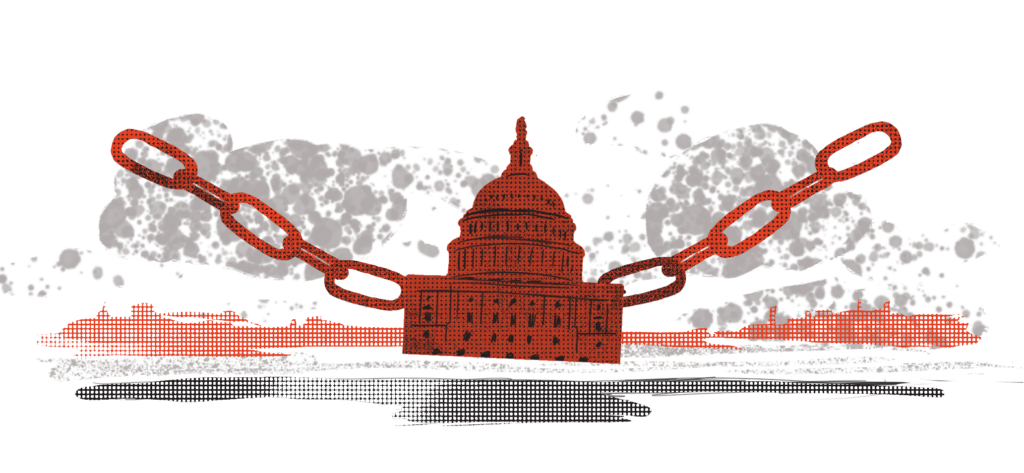
Why Is There So Little Development Along the Potomac?
You can blame—or thank—the federal government.
Think of a great American waterfront city. It’s a good bet Washington isn’t the first (or third or fifth) place that springs to mind. Unlike in Seattle, say, or Chicago—where water is a focal point for countless restaurants, office buildings, and tourist destinations—the vast majority of our riverfront, particularly on the Potomac, has been left undeveloped. Why? In short, because of the federal government.
While the feds hold 75 percent of the land along the Anacostia, they have an even bigger stake along the Potomac, where they control a whopping 88 percent of the riverfront. They’re especially protective of that land because keeping it flat and green preserves views to and from the National Mall and monumental core. “I’d think [a developer] would have as much chance of going into Yellowstone and saying, ‘Hey, I want to privatize part of this,’ ” says Monty Hoffman, who built the Wharf. (That development is technically on the Washington Channel, not the Potomac, and the city of DC, not the federal government, held the land where it now sits.)
Herb Miller is the only developer who has ever built a mixed-use destination on the Potomac inside the District. His Washington Harbour on the Georgetown waterfront replaced a concrete plant when it was erected in the 1980s. A railroad company, not the government, owned the site and agreed to partner with Miller on turning it into offices, apartments, and restaurants. Miller’s experience there highlights another challenge of building on the water: Though he didn’t have to wrest control of the land from the feds, he did have to contend with vehement neighborhood opposition. Things got so heated, he says, that he hired private security. His answer to why so few people have tried to build on the Potomac? “You have to be a true masochist.”
—Marisa M. Kashino
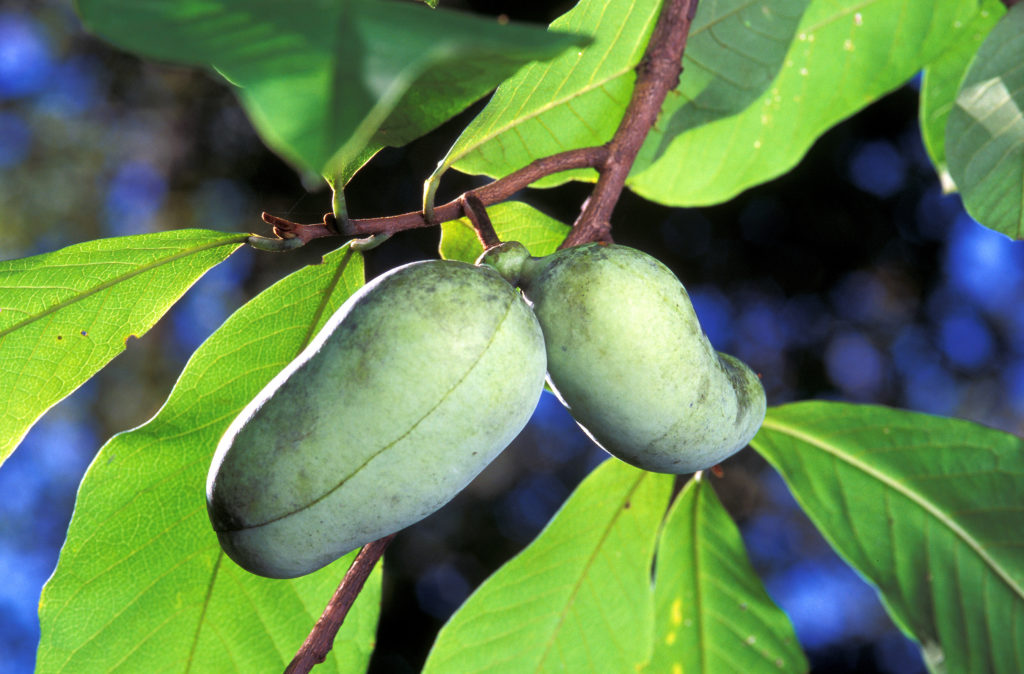
Three Fascinating Plants to Look for in the Potomac Watershed
Pawpaw
It resembles a mango and tastes a bit like one, too. You can find pawpaw trees along the C&O Canal towpath—and can pick up to a half gallon’s worth per person per day. You can also find them at farmers markets and gourmet shops in the fall.
Jewelweed
In bloom from July into October, orange jewelweed can be found along streams. The sap in its stem is medicinal—when applied to skin, it can soothe rashes from poison ivy and stinging nettles. Kids (and some adults) love giving the fat, explosive seed pods a shake.
Persimmon
The scaly, patchwork bark of this tree, which can reach heights of 60 feet, is one of its most distinctive features. The other is its orange fruit—which is quite inedible until it has fallen to the ground or weathered the first freeze of the fall.
Back to TopPresidents and the Potomac
George Washington, whose Mount Vernon estate rested along it, called the Potomac “one of the finest rivers in the world.” He isn’t the only commander in chief who has had a connection—good or bad—to the waterway.
John Quincy Adams
In nicer weather, the sixth President started each day by swimming for as long as an hour in the river—stripping naked to jump in, as was the custom.
Theodore Roosevelt
The nature lover, according to WhiteHouseHistory.org, once led the French ambassador “over cliffs and slippery rocks, through briars . . . and mud” on a hike of the rocky shore near Chain Bridge.
Grover Cleveland
To escape the stresses of the White House, Cleveland occasionally checked into Pennyfield House, which once stood at milepost 22 of the C&O Canal, to fish for bass.
Warren Harding
Memorial Bridge was finally built after the 29th President and other dignitaries got stuck in a three-hour traffic jam on an old wood-en bridge that was once the crossing from DC to Arlington, according to WhiteHouseHistory.org.
Harry Truman
The 33rd President loved to play poker on the then–presidential yacht, Williamsburg. According to Archives.gov, he and his fellow players would board Friday afternoon and set sail on the Potomac until Sunday afternoon.
Richard Nixon
Nixon used the Sequoia, another former presidential yacht, more than 80 times, often sailing to Mount Vernon to salute George Washington’s tomb, according to Politico.com. While aboard, he also told his family of his decision to resign.
Donald Trump
In 2010, more than 400 trees were clear-cut at Trump National Golf Club—Trump told a Washington Post reporter it was so members could have a better view. In 2019, the club was fined for taking down a dozen more trees without a permit.

Three Animals You May Be Surprised to See in the Potomac
Dolphins
Melania Trump recently had a second baby. Well, a dolphin named after her did. The more than 1,200 bottlenose dolphins identified by the Potomac-Chesapeake Dolphin Project are named after Washington figures.
Where to try seeing one: Virginia’s Northern Neck, where the lower Potomac is more brackish.
River Otters
They’re elusive, and thus hard to spot, but the North American river otter is native to the Potomac.
Where to try seeing one: Occoquan Bay National Wildlife Refuge in Woodbridge. Otters are active at night, so your chances are better at sunrise or sunset.
Eels
North American eels used to be abundant, until a West Virginia dam blocked their path. Proposed “eelways” could lift them over the dam.
Where to try seeing one: You really want to? They’re kind of creepy. Maybe it’s enough to know they may be coming back.
This feature originally appeared in our September, 2020 issue. It has been corrected since it was first posted online.
